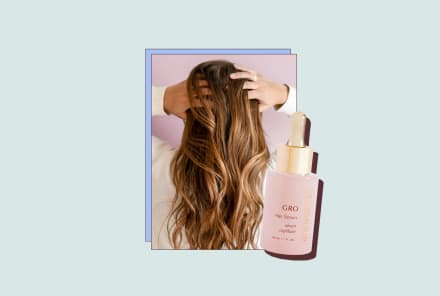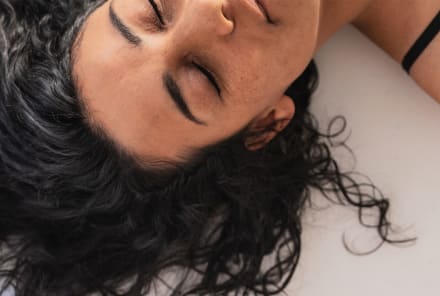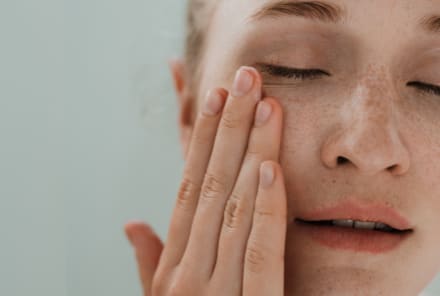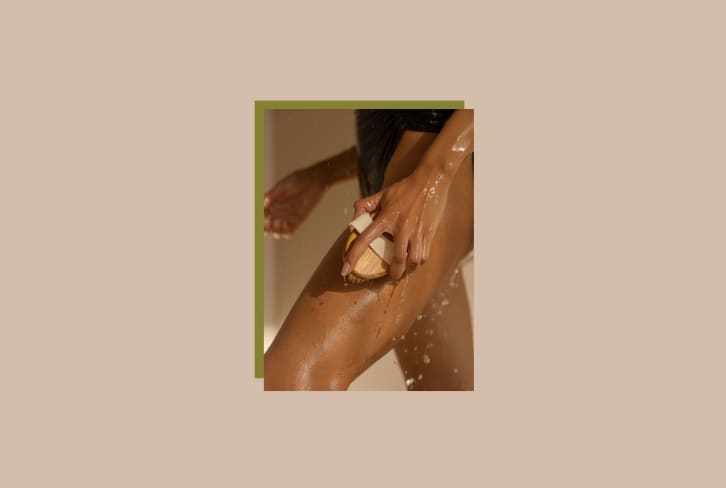Advertisement
Do Dermarollers Work? What To Expect, Cautions + How To Know If It's Right For You

Hannah Frye is the Assistant Beauty Editor at mindbodygreen. She has a B.S. in journalism and a minor in women’s, gender, and queer studies from California Polytechnic State University, San Luis Obispo. Hannah has written across lifestyle sections including health, wellness, sustainability, personal development, and more.
Just because you can do something yourself, does that always mean you should? When it comes to skin care, experts say not so much–especially if you're only doing it because it's trendy.
We're back at it again with another buzzy skin care tool made DIY-friendly (or so it seems). This time we're breaking down the benefits of dermarolling and what you need to know about doing it at home, dermarolling for hair growth, who should avoid it, and the full how-to. Let's dive in.
What are dermarollers?
Dermarollers are skin care tools that contain hundreds of tiny needles. These tools are different from those used in professional microneedling treatments, as those put tiny needles straight into the skin (like a stamp), whereas dermarollers literally roll over the skin. Plus, the in-office needles generally penetrate deeper because they use longer, sharper needles.
Many skin care experts like aestheticians and dermatologists, for example, have microneedling tools in-office should their clients want the service, but they don't often have the at-home-style dermarollers.
While traditional microneedling has been used commercially since the '90s, at-home dermarollers have become more popular over the past few years, especially with the rise of beauty TikTok.
These tiny needles have been sought after for their ability to renew the skin and ease the appearance of scarring, stretch marks, alopecia, and more. But are you really going to get those dramatic results from a DIY tool? More on that in a bit. But first, let's chat about the benefits.
Summary
What do dermarollers do for the skin?
As mentioned above, there are certainly benefits to dermarolling, should it be done properly. Here, board-certified dermatologist Michelle Henry, M.D., FAAD, explains:
Skin longevity
"When used on the face, dermarollers pierce the stratum corneum layer of the epidermis (the uppermost layer), creating minute punctures," Henry explains. "This ultimately leads to the triggering of our body's wound-healing process and the release of growth factors that stimulate cell regeneration and the production of collagen and elastin," she continues.
Translation? When your skin kicks into recovery mode, even if it's from a small injury, your collagen and elastin production are triggered, thus contributing to tighter, more supple facial skin. This, in turn, may result in the easing of fine lines and wrinkles, Henry notes.
Deeper penetration of products
"The dermaroller also creates microchannels that allow for increased product absorption into the skin, making products applied to the face more effective," certified trichologist, celebrity stylist, and founder of scalp-first hair care brand Act+Acre Helen Reavey tells mbg.
When used in conjunction with healthy skin aging products like face creams, studies have demonstrated the power microneedling has to essentially supercharge the effects of a topical product1—which can be both good and bad (more on that to come).
For hair growth purposes, dermarolling can also be used along with hair growth serums to boost their power—more on scalp treatment to follow.
Tend to scar tissue
"Through the production of these structural skin proteins, dermarollers can help ease the signs of certain skin concerns, such as acne scars," Henry notes. Whether it be indented scars from cystic acne, previously picked-at breakouts, or even stubborn hyperpigmentation, microneedling can help to press restart on the skin post-acne treatment.
It's important to note that professionals most often recommend skipping any active breakouts when dermarolling, as opening the pimple or penetrating the cyst can lead to pain, infection, and redness.
Can I use a dermaroller at home? Yes, but do so with extreme caution — if at all.
So all of those benefits sound great, but is it worth spending money on an at-home tool? Well, it all depends on how loyal you are to the process and what your goals are, as this is nowhere near a one-and-done deal—there are in-depth cautions, techniques, and cleaning protocols you have to follow.
And if you don't, you may risk harming your skin, causing infection, etc. Plus, "The tools used by dermatologists are often electric-operated and can penetrate deeper, stimulating more robust rejuvenation," Henry says.
We'd be careless to not mention the fact that there are plenty of other at-home steps you can take to tend to light acne scars and hyperpigmentation, reduce the look of fine lines and wrinkles, and help your products penetrate deeper into the skin, sans tiny rolling needles.
Also, deeper acne scars, often referred to as "ice pick," or "indented," scars, are extremely difficult to treat at home, even with a dermaroller, as the depth of professional needles generally leads to the best results—and it often takes more than one session.
However, if you still want to experiment with dermarolling and give the DIY method your best shot before buying a professional microneedling treatment, that's fair—but still, proceed with caution.
What to know about dermarolling at home:
If you are going to use a dermaroller at home, you should keep the following tips in mind:
- You have to do it on freshly clean skin, with no blemishes or wounds.
- You must clean the roller before and after use.
- Don't store it in a place where it can get dirty and potentially transfer bacteria (i.e., on your bathroom sink).
- Be careful with the products you use after (more on that to come).
- Be mindful of how often you do it.
- Don't go over the same area too many times.
If you can't commit to the above, then at-home dermarolling may not be for you. Instead, opt for in-office microneedling for all of the same benefits (and more!), without extra steps.
How to use a dermaroller at home
However, if you know you can be diligent and committed to the process, then here are the steps you should take to dermaroll at home:
Cleanse your skin.
Don't ever use your dermaroller on skin that hasn't been properly cleansed. You can choose to do a double-cleanse if you're wearing makeup or SPF, or stick with a single gentle cleanser. Gently dab your face with a clean rag afterward to make sure all of your products have been washed off.
Avoid any irritating cleansers—stay away from chemical exfoliants like AHAs and BHAs, benzoyl peroxide, and harsh physical scrubs before you use your dermaroller.
Cleanse your tool.
This part is nonnegotiable (and you'll do it again after it touches the skin). "The best way to clean the tool is to first rinse it under lukewarm water, and then wipe or soak it for about five to 10 minutes in 70%+ ethyl or isopropyl alcohol," Henry explains.
"Finally, you can pat the tool dry using a clean washcloth. Repeat this same step once you finish working on the skin," she finishes. This will ensure the tool is free of bacteria and any buildup.
Roll it on gently.
Lightly roll the dermaroller over your skin, without adding any pressure. You don't have to press the tool into the skin, as the needles will penetrate on their own and extra force may lead to irritation.
For the first few times dermarolling, go over each area of the face just once. "Dermarollers can be applied two to four times to the same area depending on one's sensitivity," Henry says—but you'll want to start out slow and see what your skin can tolerate.
"Thicker areas of the face can benefit from slightly higher frequencies of dermarolling, while the thinner more sensitive areas can become more easily irritated," Henry notes. So stick to a once-over on areas like the forehead and chin. For the cheeks, you may be able to go over the area twice.
Cleanse your tool again.
You'll want to cleanse your tool after rolling it on the skin, so follow the same steps as above.
Follow up with hydrating, soothing topicals.
"As dermarolling can cause some skin irritation at first, it's optimal to use skin care products that add extra hydration and nourishment," Henry says. Stick with bland moisturizers and hydrating serums, Henry notes, like the Kiehl's Ultra Facial Cream or Pipette Baby Balm.
A few ingredients to add to your post-dermaroller routine include:
- Hyaluronic acid
- Glycerin
- Panthenol (provitamin B5)
- Squalene
- Aloe vera
- Shea butter
- Calendula
- Jojoba oil
Stick with a gentle, simple routine for at least a few days, or a week if you have sensitive skin.
Can you dermaroll your hair & scalp?
As mentioned above, microneedling has been used as a treatment for alopecia, or hair loss. While dermarollers can be used to promote hair growth, you'll have to be as cautious when it comes to protocol.
"The needles work to create microchannels on the scalp that help to increase blood flow to the hair follicle and release growth factors," Reavey says. "It's an amazing tool to implement for accelerated hair growth rates," she continues.
Microneedling and dermarolling on the scalp help to increase the absorption and penetration of treatments within the skin and prevent thinning and balding caused by temporary hair loss, Reavey says.
Your scalp may be a bit less sensitive than your face, too. "The skin is a bit thicker and has a greater abundance of sebaceous glands, which produce sebum to protect your hair," Reavey explains.
If you're going to use a dermaroller on your scalp, be sure to do so on freshly cleansed hair and follow up with a hydrating scalp serum—may we suggest the Act+Acre Dermaroller Growth System Set that comes with both?
You can also visit a trichologist or dermatologist for microneedling on the scalp if you'd rather not go through the process at home.
As you now know, circulation is key when it comes to triggering increased growth and both preventing and treating hair loss—and dermarolling on the scalp is just one way to do so. You can also practice less invasive methods such as scalp massage, scalp and hair oiling, and consider hair growth serums and supplements if dermarolling isn't for you.
Can you dermaroll over a beard?
You can use a dermaroller on the beard to encourage growth as well, Reavey notes. Here's a few specific tips to keep in mind if you plan on using your dermaroller on your beard:
Deeply cleanse your facial hair before, as it easily holds on to bacteria, oils, etc.
You may need to go over the area more than once, as facial hair can interfere with needle penetration.
Hydrate the skin afterward, even on areas with facial hair.
Can you dermaroll your neck and chest?
As mentioned before, dermarolling should be used with extreme caution on areas with thinner skin, like the neck. If your neck is your main area of concern, you may want to visit a professional for lasting, noticeable results, without added risk.
Professional microneedling
As mentioned throughout, professional microneedling treatments are a much safer option than dermarolling at home, and they're going to be more effective in the long run. What's more, plenty of microneedling treatments are used with other tools like LED light therapy, for example.
Plus, the professional tools used often have adjustable needle lengths, meaning you can use shorter needles on areas with thin skin (like the nose, chin, forehead, etc.) and longer ones on thicker areas like the cheeks. This helps to ensure you're never penetrating too deeply.
And moreover, your dermatologist or aesthetician will let you know if you're a good candidate for this procedure—as microneedling is not right for everyone. Those with active acne, rosacea, psoriasis, or other inflammatory skin conditions may actually be better off without it—professional-grade treatment or not.
Is it right for you? Here's how to know.
While it can feel exciting to try out a new-to-you skin care tool that people have raved about on social media or by word-of-mouth, your skin can't always take trend after trend. Your skin is unique, and how you care for it should be as well.
And to that end, plenty of people praise dermarolling because it can cause products to penetrate deeper into the skin. While this is great for those hydrating humectants like hyaluronic acid and aloe vera, it's not entirely necessary when it comes to strong actives like retinoids.
As your derm will tell you—these prescription-grade products and even some OTC retinols and exfoliants generally penetrate the skin just fine on their own. And as long as you clear out dead skin cells via exfoliation, the products will get into the skin as need be. Thus, why you don't need dermarolling to make sure your skin care "works"—high-quality products used in a dedicated routine will do that on their own.
So if you want to use dermarolling to ease acne scars, encourage hair growth, or contribute to skin longevity—do it, but with caution. However, if you're just doing it to do it, without proper technique and any significant reason, you may want to ask yourself if you're more motivated by the benefits or the fact that it's trending (and yes, we've all been there).
FAQ
Does dermarolling hurt?
If you're using an at-home dermaroller with needles less than or equal to 0.25mm in length, you likely won't experience pain. However, some people are more sensitive than others. In-office microneedling treatments may induce more pain as a sharper, longer needle is used. In these procedures, numbing gel is often used to manage discomfort.
Is dermarolling the same as microneedling?
Dermarollers are skin care tools that contain hundreds of tiny needles. These tools are different from those used in microneedling, as the latter deposits tiny needles straight into the skin (like a stamp), whereas dermarollers literally roll over the skin. Plus, the in-office needles generally penetrate deeper as they use longer, sharper needles.
Do dermarollers work for beard growth?
Dermarollers can stimulate hair growth on the scalp, beard, and eyebrows. In-office microneedling treatments may produce more dramatic results than at-home tools; however, the latter will still be helpful.
Are dermarollers bad for your skin?
Dermarollers can help the skin in certain cases, like tending to acne scars or encouraging hair growth; however, they must be used with caution. If they are not cleansed before and after, used properly, and strict aftercare is not followed, then you run the risk of experiencing infection, irritation, etc.
The takeaway
While you can get an at-home dermaroller for DIY-style microneedling, it won't produce the same dramatic effects. In-office tools have longer, sharper needles and penetrate the skin differently, making them more effective.
If you do want to use a dermaroller at home for hair growth, acne scars, etc., be sure to cleanse it properly and do so with caution. Plus, don't forget that commitment to a full skin care routine should never be overlooked—so start here.
Watch Next
Enjoy some of our favorite clips from classes
Enjoy some of our favorite clips from classes
What Is Meditation?
Mindfulness/Spirituality | Light Watkins
Box Breathing
Mindfulness/Spirituality | Gwen Dittmar
What Breathwork Can Address
Mindfulness/Spirituality | Gwen Dittmar
The 8 Limbs of Yoga - What is Asana?
Yoga | Caley Alyssa
Two Standing Postures to Open Up Tight Hips
Yoga | Caley Alyssa
How Plants Can Optimize Athletic Performance
Nutrition | Rich Roll
What to Eat Before a Workout
Nutrition | Rich Roll
How Ayurveda Helps Us Navigate Modern Life
Nutrition | Sahara Rose
Messages About Love & Relationships
Love & Relationships | Esther Perel
Love Languages
Love & Relationships | Esther Perel

















